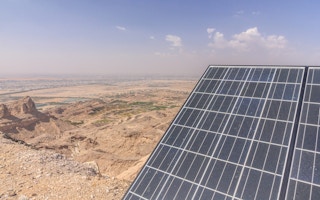As the Gulf states take steps to expand their use of clean energy, a bold plan by the United Arab Emirates to boost its use of renewable electricity from less than 1 per cent to 24 per cent in the next five years could be a game-changer for the region, experts say.
Much of the world is moving away from oil for its electricity generation, according to the International Energy Agency (IEA), which says that globally the fossil fuel has dropped from a 25 per cent share to 3.6 per cent over the last four decades.
Countries in the Middle East, however, have been bucking the trend. The IEA predicts that by 2019, the region - which holds one-third of the world’s proven crude oil reserves - will still be generating nearly one-third of its electricity from oil, with Kuwait and Saudi Arabia leading the way.
But dropping oil prices and growing concerns about climate change have exposed the downsides of relying on oil. As the Gulf’s demand for power continues to rise, the UAE is leading the way in shifting to greener energy resources.
“The implications of unmitigated climate change for the UAE make its cities unbearably hot, water even more scarce and the region more unstable,” Rachel Kyte, the CEO of the United Nations’ Sustainable Energy for All initiative, told the Thomson Reuters Foundation.
“Action alone and collectively to live in balance with the planet is fundamental for UAE’s future prosperity,” she said.
Solar giant?
At the Middle East and North Africa Renewable Energy Conference in Kuwait last month, the Gulf Cooperation Council (GCC) states - Bahrain, Kuwait, Oman, Qatar, Saudi Arabia and the UAE - pledged to mobilise $100 billion into renewable energy projects over the next 20 years.
One of the projects in the UAE’s renewables push is the $13.6 billion Mohammed bin Rashid Al Maktoum Solar Park in Dubai, which aims to become the biggest solar power plant in the Middle East.
“
Low oil prices and the need for clean air and secure supply chains of food and water all reinforce the wisdom of the UAE in taking a long-term view and moving to be a leader in renewable energy and energy productivity.
Rachel Kyte, CEO, UN Sustainable Energy for All
It is expected to generate 5 gigawatts of electricity - enough to power 1.5 million homes - by 2030.
Dubai also plans to install around 100 electric car charging stations as part of its Green Charger Initiative.
By 2050, Dubai wants to reduce its carbon emissions by 6.5 million tons every year, with the aim of becoming the city with the world’s lowest carbon footprint, according to the Dubai Electricity and Water Authority.
Meanwhile, Saudi Arabia has said it wants to add another 9.5 GW of renewable energy capacity to its current capacity of 80 GW by 2030, And Oman’s power sector regulator, the Authority for Electricity Regulation Oman, has announced it will expand rooftop soar installations across residential homes, industrial and commercial buildings.
In Qatar, French energy giant Total SA has announced a joint venture worth $500 million with state-run petroleum, electricity and water companies to develop a solar-power project with a capacity of 1,000 megawatts (MW).
And with a 70 MW solar project due to be operational by 2017, Kuwait plans to meet 15 per cent of its energy needs with renewables by 2030, according to the Kuwait Institute of Scientific Research.
“Diversification is key,” said Kyte. “The speed with which previously oil-dependent countries embrace diversification will be a factor in how well they thrive during the energy transition that is now underway.”
Growing demand for power
It won’t be easy for the Gulf to wean itself off of fossil fuels. In a report released earlier this month, the Arab Petroleum Investments Corporation, a multilateral development bank, said the Gulf Cooperation Council states need to add 69 GW of electrical production to their current total capacity of 148 GW in the next five years to meet demand.
Member states currently rely on hydrocarbon exports for 80 per cent of their revenue. The global collapse in oil prices has rocked the region, which lost $287 billion in oil export income - almost 21 per cent of GDP - in 2015, according to the International Monetary Fund.
But experts say the sunny region is in a prime position to use renewable energy - particularly solar power - both to meet its own energy needs and bring in much-needed revenue.
The region already has some of the infrastructure it needs to become a major clean-power hub. The Gulf Cooperation Council countries are linked by a 1,200-km electrical grid, built to help provide backup power in case of a blackout in one part of the system.
Expanded to other countries, that electricity highway could be the backbone of future power trading, experts say.
“The Gulf has an exportable resource in solar energy that could eventually be on a comparable level to oil and gas,” said Jonathan Walters, a former director at the World Bank.
“Low oil prices might impel Gulf countries to find alternative exports,” he said. And if prices rise again, domestic use of solar could soar, he said.
Experts said they hope the rest of the Gulf States will look to the UAE as an example of how to tap into clean energy’s potential.
“Low oil prices and the need for clean air and secure supply chains of food and water all reinforce the wisdom of the UAE in taking a long-term view and moving to be a leader in renewable energy and energy productivity,” Kyte said.
“Now we hope the UAE can share its lessons in the GCC and across the developing world,” she said.
This story was published with permission from the Thomson Reuters Foundation, the charitable arm of Thomson Reuters, that covers humanitarian news, climate change, women’s rights, trafficking and property rights. Visit http://news.trust.org/climate.

















